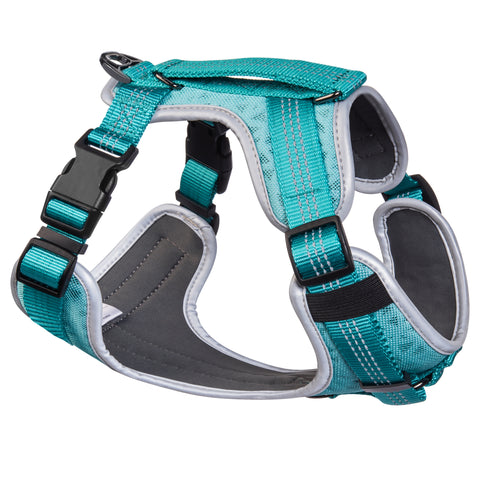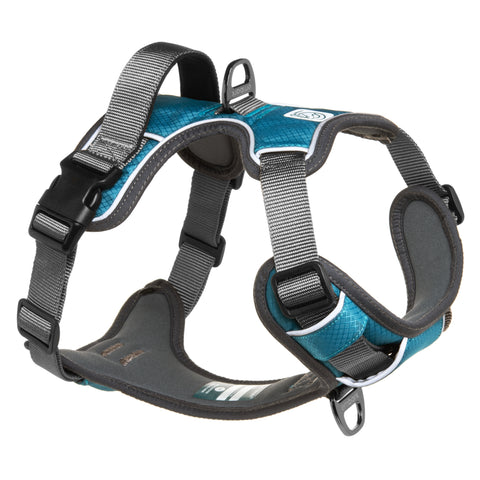Harnesses vs Collars - What We Prefer and Why

A lot of dog parents ask us whether we prefer harnesses or collars, and the short answer to that is that although we prefer harnesses for our dogs over collars, a collar can still be a great option for the right dog. We’ve done a lot of research into this as we designed our harness and thought we would share some of the findings about why we ultimately decided to create a harness.

Thyroid Problems
The anatomy of a dog’s neck is very similar to our own. This means that when a dog is wearing a collar, it usually rests right where the thyroid gland is. When a dog pulls against the collar, the thyroid gland can become inflamed and damaged. Over time, this can cause all kinds all kinds of symptoms because the thyroid gland influences your dog’s metabolism. Symptoms can include weight gain/loss, fatigue, skin or hair problems, etc..
Neck Injuries
As you can imagine having something around your neck can cause quite a lot of pain or damage if the leash is suddenly jerked. If your dog got distracted and ran after something, this can cause a serious injury like whiplash, spinal cord injury, damaged larynx, trachea, or vertebrae, etc… It can also cause nerve damage. Dr. Peter Dobias talks about how leash pulling can affect the nerves running down the front legs. This can cause dogs to feel an “abnormal sensation” in their front paws, which can cause them to lick their feet an excessive amount.
Although we love our dogs (and maybe sometimes even more so than our human friends!), dogs are physically different. Dogs respond to pain differently, and just because your dog continues to pull and doesn’t show signs of pain doesn’t necessarily mean that they weren’t injured in the process.
Ear and Eye Injuries
It was found in a study in 2006 that pressure on dog’s neck similar to the force of a collar can cause an increase in pressure in the eyes. This can worsen conditions such as glaucoma or thin corneas.
What Dogs are Suitable for Collars
Although we personally prefer harnesses, a collar can still be a suitable option for a dog who doesn’t pull or lunge and does not have any respiratory or tracheal problems. It does not matter the size of your dog. Large or small as long as the dog doesn’t have any of the above behavioral or physical conditions.

The Best Alternative to Collars
After speaking to many vets and animal experts from organizations like PETA and through our personal experience, we believe that the best alternative to a collar is a harness. A good, comfortable dog harness will distribute the pressure across the dog’s chest, and torso and reduce the pressure on the neck.
The right harness for your dog should fit be snug but still allow free movement of your dog’s limbs. You don’t want your dog to chafe, but at the same time, if it is too loose, your dog may easily slip out of it. We have written a full harness adjustment guide with full directions on how to achieve this fit.
The Adventure Dog Harness has two attachment points, one at the front near the chest, and one on the back. This gives you two ways to use the harness. If your dog pulls, this redirects the dog and spins them around, so they start to learn to not pull without hurting them. However, it is important that you also train your dog not to pull. The harness alone will not train your dog to not pull. If your dog is already trained or does not pull, then you can use the ring attachment on the back.
There is a myth that harnesses actually cause dogs to pull more, but actually what is happening is that because a harness distributes the pressure points across the dog’s entire body instead of just the neck, a dog is able to leverage themselves a bit better than a collar, so it appears that they are pulling more. So in order to train your pup correctly if your dog pulls is to switch to the front attachment ring. They will gradually learn to stop pulling once they realize that it doesn’t work.
Truth be told, we love our harnesses, but we do understand that all dogs are different, so you need to decide what works best for you and your dog. Hopefully, all the research that we did prior to creating our first harness was helpful for you in making that decision.




I have the same sentiments. I have a golden retriever and he seems to be bothered with a collar. I also don’t like that it marks on her neck so I always opt for the body hugging ones.
my adventure harness has just been delivered. i am very impressed with the quality of the harness. The instructions on how to adjust it are clear and seeing it put on a dog was useful. when my pup wakes up putting on the harness will be today’s new game.
Leave a comment